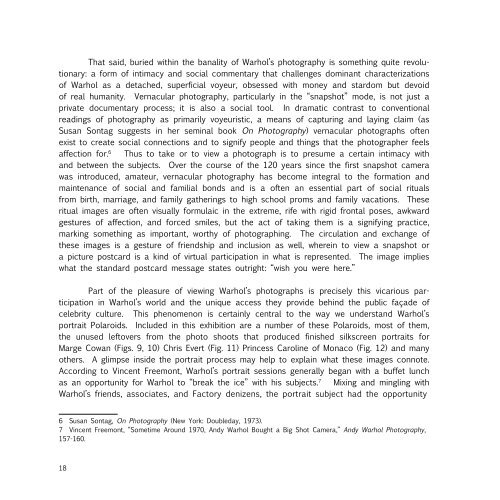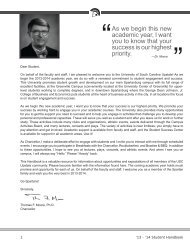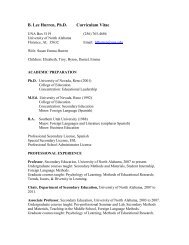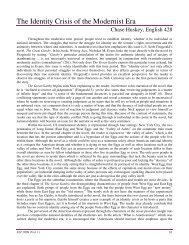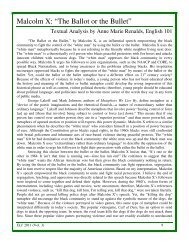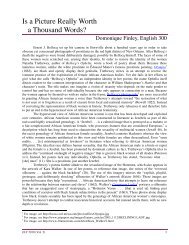The Andy Warhol Photographic - University of South Carolina Upstate
The Andy Warhol Photographic - University of South Carolina Upstate
The Andy Warhol Photographic - University of South Carolina Upstate
Create successful ePaper yourself
Turn your PDF publications into a flip-book with our unique Google optimized e-Paper software.
That said, buried within the banality <strong>of</strong> <strong>Warhol</strong>’s photography is something quite revolutionary:<br />
a form <strong>of</strong> intimacy and social commentary that challenges dominant characterizations<br />
<strong>of</strong> <strong>Warhol</strong> as a detached, superficial voyeur, obsessed with money and stardom but devoid<br />
<strong>of</strong> real humanity. Vernacular photography, particularly in the “snapshot” mode, is not just a<br />
private documentary process; it is also a social tool. In dramatic contrast to conventional<br />
readings <strong>of</strong> photography as primarily voyeuristic, a means <strong>of</strong> capturing and laying claim (as<br />
Susan Sontag suggests in her seminal book On Photography) vernacular photographs <strong>of</strong>ten<br />
exist to create social connections and to signify people and things that the photographer feels<br />
affection for. 6 Thus to take or to view a photograph is to presume a certain intimacy with<br />
and between the subjects. Over the course <strong>of</strong> the 120 years since the first snapshot camera<br />
was introduced, amateur, vernacular photography has become integral to the formation and<br />
maintenance <strong>of</strong> social and familial bonds and is a <strong>of</strong>ten an essential part <strong>of</strong> social rituals<br />
from birth, marriage, and family gatherings to high school proms and family vacations. <strong>The</strong>se<br />
ritual images are <strong>of</strong>ten visually formulaic in the extreme, rife with rigid frontal poses, awkward<br />
gestures <strong>of</strong> affection, and forced smiles, but the act <strong>of</strong> taking them is a signifying practice,<br />
marking something as important, worthy <strong>of</strong> photographing. <strong>The</strong> circulation and exchange <strong>of</strong><br />
these images is a gesture <strong>of</strong> friendship and inclusion as well, wherein to view a snapshot or<br />
a picture postcard is a kind <strong>of</strong> virtual participation in what is represented. <strong>The</strong> image implies<br />
what the standard postcard message states outright: “wish you were here.”<br />
Part <strong>of</strong> the pleasure <strong>of</strong> viewing <strong>Warhol</strong>’s photographs is precisely this vicarious participation<br />
in <strong>Warhol</strong>’s world and the unique access they provide behind the public façade <strong>of</strong><br />
celebrity culture. This phenomenon is certainly central to the way we understand <strong>Warhol</strong>’s<br />
portrait Polaroids. Included in this exhibition are a number <strong>of</strong> these Polaroids, most <strong>of</strong> them,<br />
the unused leftovers from the photo shoots that produced finished silkscreen portraits for<br />
Marge Cowan (Figs. 9, 10) Chris Evert (Fig. 11) Princess Caroline <strong>of</strong> Monaco (Fig. 12) and many<br />
others. A glimpse inside the portrait process may help to explain what these images connote.<br />
According to Vincent Freemont, <strong>Warhol</strong>’s portrait sessions generally began with a buffet lunch<br />
as an opportunity for <strong>Warhol</strong> to “break the ice” with his subjects. 7 Mixing and mingling with<br />
<strong>Warhol</strong>’s friends, associates, and Factory denizens, the portrait subject had the opportunity<br />
6 Susan Sontag, On Photography (New York: Doubleday, 1973).<br />
7 Vincent Freemont, “Sometime Around 1970, <strong>Andy</strong> <strong>Warhol</strong> Bought a Big Shot Camera,” <strong>Andy</strong> <strong>Warhol</strong> Photography,<br />
157-160.<br />
to chat, share stories, and engage in the social world <strong>of</strong> the Factory. Once the congenial<br />
atmosphere between photographer and subject was established, <strong>Warhol</strong> began the photographic<br />
session itself by transforming the subject for the portrait image. Women, in particular, were<br />
<strong>of</strong>ten painted with white face make-up to hide wrinkles and blemishes and enhance the contrast<br />
<strong>of</strong> the Polaroid image for the silkscreen transfer. <strong>The</strong>y also frequently disrobed and appear<br />
wrapped in a familiar blue-and-white checked sheet in order to bare their neck and shoulders<br />
for the camera. <strong>Warhol</strong> then directed the subjects as they posed for dozens <strong>of</strong> shots in a<br />
sitting, from which <strong>Warhol</strong> would select the five best candidates for the silkscreen portrait.<br />
Through this meticulous process, <strong>Warhol</strong> arrived at a completed silkscreen portrait that bathed<br />
the sitter in flawless celebrity artifice. Stylishly posed, brilliantly colored, and reducing the face<br />
to a clean, unblemished abstraction, the finished portraits inject the subject, whomever he or<br />
she may be, with <strong>Warhol</strong>’s signature star look, one that has since become a visual shorthand<br />
for celebrity vanity and narcissism. Yet the Polaroid originals and, more specifically, the Polaroids<br />
that were not chosen for silkscreening have a rather different effect. Part <strong>of</strong> this is due<br />
to the Polaroid medium itself. <strong>The</strong> small instant photos seem like silly little novelties, “test<br />
shots” or “outtakes” perhaps, the epitome <strong>of</strong> trivial vernacularity. Further emphasizing their<br />
anti-monumentality is the fact that, when given the luxury <strong>of</strong> examining a sequence <strong>of</strong> six or<br />
seven shots together, we see the cracks in the serious façade <strong>of</strong> <strong>Warhol</strong>’s rich and powerful<br />
portrait subjects begin to emerge. <strong>The</strong> shy playfulness or silly pomposity <strong>of</strong> fashion designer<br />
Gianfranco Ferré (Fig. 13, 14), socialite and art collector Sao Schlumberger (Fig. 15, 16) and<br />
Italian art dealer Luciano Anselmino (Fig. 17 – 20) reveal themselves in a poorly timed blink, a<br />
stifled laugh, a flicker <strong>of</strong> boredom, or a brooding seriousness and formal affectation that comes<br />
<strong>of</strong>f as slightly ridiculous in the Polaroid photo. If the final silkscreen portrait is an exercise in<br />
constructing celebrity artifice (even for those who might not be recognizably famous to begin<br />
with), then the photo session reveals glimpses <strong>of</strong> the charming, slightly flawed humanity that<br />
necessarily lies beneath the glittering superficiality. Caught in the Polaroid moment, <strong>Warhol</strong>’s<br />
subjects let slip their true selves, foibles and all, in the very act <strong>of</strong> trying to obscure them.<br />
Also included in the selection here are a small sampling <strong>of</strong> the tens <strong>of</strong> thousands <strong>of</strong> blackand-white<br />
photos that <strong>Warhol</strong> shot with his Minox, Konica, Chinon, and Minolta 35mm cameras<br />
during the latter half <strong>of</strong> his career. <strong>The</strong> subjects <strong>of</strong> these photographs are both everything and<br />
nothing: friends, celebrity parties, and trips to China and Washington, DC, but also half eaten<br />
meals, shop windows, and parking lots. <strong>The</strong> images seem, in one sense, to be a sampling <strong>of</strong><br />
<strong>Warhol</strong>’s personal snapshots, yet <strong>Warhol</strong>’s glamorous lifestyle (particularly in the 1970s and<br />
18<br />
19


